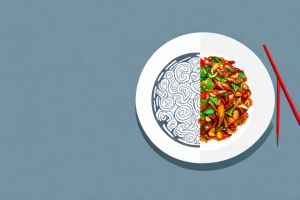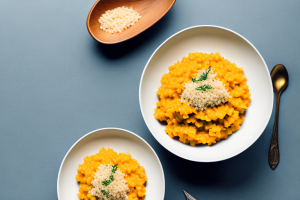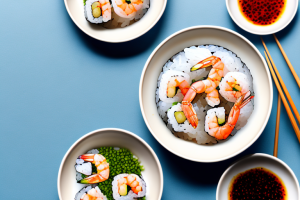How to make brown rice with curried vegetables
8 min read
A bowl of steaming brown rice with curried vegetables
For those looking for a healthy and satisfying meal, brown rice with curried vegetables is a great option. This dish not only tastes delicious, but it is packed with nutrients that are sure to leave you feeling full and satisfied. In this article, we’ll explore everything you need to know in order to make the perfect brown rice with curried vegetables.
Why brown rice is a healthy option
While white rice is a popular staple in many households, brown rice is the healthier choice. Brown rice is a whole grain, meaning it contains all parts of the grain kernel, including the fiber-rich bran and the nutrient-rich germ. This results in brown rice having more fiber, vitamins, and minerals than white rice.
In addition to its nutritional benefits, brown rice also has a lower glycemic index than white rice. This means that it causes a slower and steadier rise in blood sugar levels, making it a better option for those with diabetes or anyone looking to maintain stable blood sugar levels. Brown rice also contains antioxidants that can help protect against chronic diseases such as cancer and heart disease.
The nutritional benefits of curried vegetables
Adding vegetables to your curry not only enhances the flavor but also boosts the nutritional value of your meal. Curried vegetables are an excellent source of fiber, vitamins, and minerals such as vitamin C, vitamin K, and potassium. Additionally, the spices used in curry have anti-inflammatory properties and have been linked to improved digestion and heart health.
One of the most significant benefits of curried vegetables is their ability to aid in weight management. Vegetables are low in calories and high in fiber, which helps you feel full and satisfied for longer periods. This can prevent overeating and promote weight loss. Moreover, the spices used in curry, such as turmeric, have been shown to increase metabolism and promote fat burning.
Another benefit of curried vegetables is their potential to reduce the risk of chronic diseases. The antioxidants found in vegetables and spices can help protect against cell damage and inflammation, which are linked to various diseases such as cancer, diabetes, and Alzheimer’s. By incorporating curried vegetables into your diet, you can improve your overall health and reduce the risk of developing these conditions.
Simple ingredients needed to make brown rice with curried vegetables
Although this dish may sound complex, it’s actually easy to make with just a few simple ingredients. Here’s what you’ll need:
- 1 cup of brown rice
- 2 cups of water
- 1 tablespoon of oil
- 1 onion, chopped
- 2 cloves of garlic, minced
- 1 teaspoon of turmeric
- 1 teaspoon of cumin
- 1 teaspoon of coriander
- 1/2 teaspoon of chili powder
- 2 cups of mixed vegetables (carrots, bell peppers, broccoli, etc.)
- Salt and pepper to taste
To make this dish even more flavorful, you can add some additional spices such as garam masala or curry powder. You can also experiment with different types of vegetables to find your favorite combination. This dish is not only delicious, but it’s also a great way to incorporate more vegetables into your diet. Plus, it’s a perfect meal prep option for busy weeknights!
Step-by-step cooking instructions for the perfect brown rice with curried vegetables
Follow these simple steps to make the perfect brown rice with curried vegetables:
- Rinse the brown rice thoroughly and add it to a pot with 2 cups of water. Bring to a boil, then reduce heat to low and cover. Allow the rice to simmer for 40-45 minutes or until all the water has been absorbed.
- While the rice is cooking, heat oil in a separate pan over medium heat. Add onions and garlic, cooking until translucent.
- Add turmeric, cumin, coriander, and chili powder and stir well.
- Add mixed vegetables and sauté until tender.
- When the brown rice is cooked, remove it from heat and let it sit for a few minutes until it’s cooled enough to be handled.
- Add the vegetable mixture to the rice and stir well. Season with salt and pepper to taste.
For an added burst of flavor, you can also add a handful of raisins or chopped nuts to the rice and vegetable mixture before serving. This will give the dish a sweet and nutty taste that complements the savory flavors of the curry. Additionally, you can garnish the dish with fresh cilantro or parsley for a pop of color and added freshness.
Choosing the right spices for your curried vegetables
The combination of spices used in your curry can greatly affect its taste and nutritional value. It’s important to choose spices that not only taste good but also offer health benefits. Turmeric, for example, is known for its anti-inflammatory properties, while cumin has been linked to improved digestion.
Other spices that can be added to your curried vegetables include coriander, which is rich in antioxidants, and ginger, which has anti-nausea and anti-inflammatory properties. Additionally, adding black pepper to your curry can enhance the absorption of turmeric in your body. Experiment with different spice combinations to find the perfect flavor and health benefits for your curried vegetables.
How to achieve the perfect texture of brown rice
For the perfect texture of brown rice, it’s important to rinse the rice thoroughly and cook it for the right amount of time. Brown rice needs a longer cooking time than white rice, usually around 40-45 minutes. You can also add a bit of oil to the pot when cooking brown rice to prevent it from sticking.
Another tip for achieving the perfect texture of brown rice is to let it rest for 5-10 minutes after cooking. This allows the rice to absorb any remaining liquid and become fluffier. Additionally, you can try using a rice cooker to cook brown rice, as it can help ensure consistent results every time. Experiment with different cooking methods and ratios of water to rice to find the perfect texture that suits your taste.
Tips for meal prepping brown rice with curried vegetables
Brown rice with curried vegetables is a great meal prep option, as it can be easily prepared in advance and stored in the fridge for up to 5 days. To make meal prepping easier, consider cooking a large batch of brown rice and storing it in the fridge or freezer until you’re ready to use it.
When it comes to curried vegetables, you can use any combination of your favorite veggies. Some great options include cauliflower, broccoli, carrots, and bell peppers. To save time, consider using frozen vegetables that are already chopped and ready to go.
For added protein, you can also add some cooked chickpeas or tofu to the dish. This will not only make it more filling, but it will also add some extra flavor and texture. If you’re not a fan of brown rice, you can also use quinoa or another grain of your choice.
Make-ahead options for easy and convenient meal planning
If you’re looking to make meal planning even easier, consider cooking the curried vegetables in advance and storing them in the fridge or freezer until you’re ready to serve. When you’re ready to eat, simply reheat the vegetables and add them to the cooked brown rice.
Another make-ahead option is to prepare a large batch of brown rice and store it in the fridge or freezer. This way, you can easily reheat the rice and add it to any meal throughout the week, including the curried vegetables.
Additionally, you can customize this recipe by adding your favorite protein, such as chicken or tofu. Cook the protein separately and add it to the curried vegetables and rice when serving. This will add extra flavor and nutrition to the dish.
Alternatives to traditional curried vegetable recipes
There are many different ways to prepare curried vegetables, so don’t be afraid to get creative with your spice combinations and vegetable choices. You could try adding chickpeas or lentils for added protein, or swapping out the mixed vegetables for sweet potatoes or zucchini.
Another alternative to traditional curried vegetable recipes is to use coconut milk instead of cream or yogurt. This will give your dish a creamier texture and a slightly sweet flavor. You could also experiment with different types of curry powder, such as red or green curry, to add a unique twist to your dish.
If you’re looking for a low-carb option, you could try using cauliflower rice instead of regular rice to serve with your curried vegetables. This will give you all the flavors of a traditional curry dish, without the added carbs. Additionally, you could try using tofu or tempeh instead of meat for a vegetarian or vegan option.
How to store leftover brown rice with curried vegetables
If you have leftover brown rice with curried vegetables, it can be stored in an airtight container in the fridge for up to 5 days. When reheating, be sure to add a bit of water or vegetable broth to prevent the rice from drying out.
It’s important to note that reheating rice should be done thoroughly to avoid any risk of food poisoning. Make sure the rice is piping hot all the way through before consuming. If you’re not planning on eating the leftovers within 5 days, it’s best to freeze them instead. Simply transfer the rice and vegetables to a freezer-safe container and store for up to 3 months. When ready to eat, thaw in the fridge overnight and reheat as usual.
Pairing suggestions for serving brown rice with curried vegetables
Brown rice with curried vegetables pairs well with a variety of different dishes, including grilled chicken or tofu, naan bread, and a side salad. For a complete meal, consider making a raita dipping sauce with yogurt, cucumber, and mint.
Another great pairing for brown rice with curried vegetables is roasted chickpeas. Simply toss chickpeas with olive oil, salt, and your favorite spices, and roast in the oven until crispy. The texture and flavor of the chickpeas complement the rice and vegetables perfectly.
If you’re looking for a vegetarian or vegan protein source to add to your meal, try adding some lentils to the curried vegetables. Lentils are a great source of protein and fiber, and their earthy flavor pairs well with the spices in the curry. You can also serve the dish with a dollop of plain Greek yogurt or sour cream for added creaminess.
Health benefits of adding turmeric to your curry
Turmeric, a bright yellow spice often used in curries, has been linked to a variety of health benefits. It has anti-inflammatory properties and has been shown to improve brain function, lower the risk of heart disease, and even have anti-cancer effects.
How to get creative with your veggie and spice combinations
Curried vegetables are a great way to experiment with different veggie and spice combinations. Consider trying different types of vegetables, such as cauliflower or eggplant, and adjusting the spice proportions to suit your taste. You can also try adding different herbs, such as cilantro or basil, to add extra flavor.
Common mistakes to avoid when cooking brown rice and curried vegetables
Here are a few common mistakes to avoid when cooking brown rice with curried vegetables:
- Not rinsing the brown rice thoroughly, leading to a gummy texture
- Overcrowding the pan when cooking the vegetables, resulting in uneven cooking
- Using too much spice, overpowering the other flavors in the dish
- Not seasoning the dish properly, leading to a bland taste
With these tips in mind, you’ll be well on your way to making the perfect brown rice with curried vegetables. Not only is this meal flavorful and satisfying, but it’s also packed with nutrients that will leave you feeling energized and healthy.


